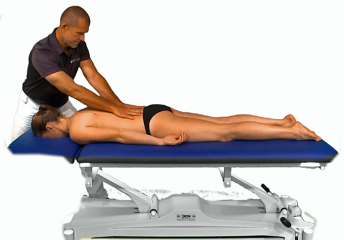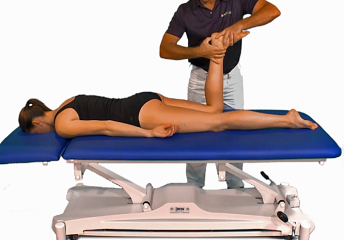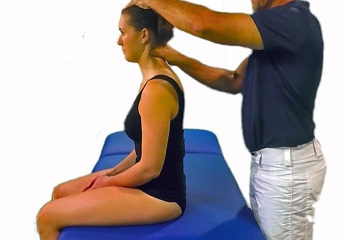Th páteř – extenze (THORACIC SPINE – EXTENSION)
Th PÁTEŘ – EXTENZE
Vyšetření
Poloha pacienta: Sedí obkročmo na okraji lehátka. Ruce jsou sepjaté v týl, lokty směřují dopředu.
Postavení terapeuta: Stojí z boku pacienta.
Provedení: Terapeut jednou rukou, za lokty pacienta, vede hrudní páteř do extenze. Ukazovákem druhé ruky palpuje vzájemné přibližování trnů, v případě blokády odpor. Palpace blokády může být prováděna také vidličkou utvořenou mezi II. a III. prstem, které přikládáme na transverzální výběžky dolního obratle vyšetřovaného segmentu. Čím nižší segmenty terapeut vyšetřuje, tím jsou lokty výše a tím větší je záklon v hrudní páteři.
Terapie
Poloha pacienta: Leží na boku. Ruce jsou sepjaté v týl, lokty směřují dopředu.
Postavení terapeuta: Stojí před pacientem.
Provedení: Terapeut svou dlaní podkládá rameno spodní horní končetiny pacienta, předloktím podkládá jeho paži a svou paží se opírá zespodu o pacientovy lokty. Ukazováčkem druhé ruky terapeut fixuje trn spodního obratle mobilizovaného segmentu. Poté terapeut provede záklon do segmentu, a tím získá předpětí.
Technika: PIR
Aktivace: Tlak loktů do paže terapeuta, nádech do místa fixace.
Relaxace: Uvolnění tlaku, maximální výdech.
Nejčastější chyby: Záklon je lokalizován v jiném než ve vyšetřovaném/mobilizovaném segmentu.
Poznámka: Poloha pacienta při vyšetření i terapii může být i běžný sed na kraji lehátka.
THORACIC SPINE – EXTENSION
Examination
Patient position: He (she) sits astride the edge of the lounger. The hands are clasped behind the back, the elbows point forward.
Position of the therapist: He (she) stands by the side of the patient.
Execution: The therapist guides the thoracic spine into extension with one hand, behind the patient's elbows. With the index finger of the other hand, palpate the mutual approach of the spines, in case of blockage, resistance. Palpation of the blockage can also be performed with a fork formed between II. and III. with a finger, which we apply to the transverse projections of the lower vertebra of the examined segment. The lower segments the therapist examines, the higher the elbows and the greater the tilt in the thoracic spine.
Therapy
Patient position: He (she) is lying on their side. The hands are clasped behind the back, the elbows point forward.
Position of the therapist: He (she) stands in front of the patient.
Execution: The therapist supports the shoulder of the lower upper extremity of the patient with his palm, supports his arm with his forearm, and rests his arm on the patient's elbows from below. With the index finger of the other hand, the therapist fixes the spine of the lower vertebra of the mobilized segment. Then the therapist performs a tilt into the segment and thereby obtains pretension.
Technique: PIR
Activation: Elbow pressure on the therapist's arm, breath on the place of fixation.
Relaxation: Release of pressure, maximum exhalation.
The most common mistakes: The tilt is located in a segment other than the investigated/mobilized segment.
Note: The patient's position during the examination and therapy can also be the usual sitting on the edge of the couch.
SOUVISEJÍCÍ

Th páteř – extenze (THORACIC SPINE – EXTENSION)

Th páteř – flexe (THORACIC SPINE – FLEXION)

Th páteř – rotace (THORACIC SPINE – ROTATION)

Th páteř – manuální trakce I (THORACIC SPINE – MANUAL TRACTION I)

Th páteř – manuální trakce II (THORACIC SPINE – MANUAL TRACTION II)



















